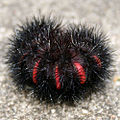Giant leopard moth
| Giant Leopard Moth | |
|---|---|

| |
| Scientific classification | |
| Kingdom: | |
| Phylum: | |
| Class: | |
| Order: | |
| Family: | |
| Tribe: | |
| Genus: | |
| Species: | H. scribonia
|
| Binomial name | |
| Hypercompe scribonia (Stoll, 1790)
| |
| Subspecies | |
| |
| Synonyms | |
| |
The Giant Leopard Moth or Eyed Tiger Moth (Hypercompe scribonia) is a moth of the family Arctiidae. It is distributed throughout the Southern and Eastern United States from New England to Mexico. The obsolete name Ecpantheria scribonia is still occasionally encountered.
This species has a wingspan of 3 inches (nearly 8 cm). The wings of this moth are bright white with a pattern of neat black blotches, some solid and some hollow. The abdomen is dark blue with orange markings, the male has a narrow yellow line on the sides. Its legs have black and white bands. Adult moths are strictly nocturnal and do not generally fly before nightfall (Fullard & Napoleone 2001).
The caterpillar is of the "Woolly Bear" kind, with a thick coat of black bristles (setae) and red or orange colored bands between its segments which become conspicuous when caterpillar rolls into a ball for defense.
Recorded food plants
The caterpillar eats a variety of broad-leaf plants such as broadleaf plantains, dandelions and violets:
|
|
Gallery
-
The larval stage
-
Caterpillar in typical defensive ball
-
Closeup of head and thorax
-
Closeup showing iridescent blue spots
-
Closeup of newly eclosed moth
-
Showing the old skin, empty pupal shell, and adult moth.
-
Last image at night before it flew off once wings dried.
References
- Fullard, James H. & Napoleone, Nadia (2001): Diel flight periodicity and the evolution of auditory defences in the Macrolepidoptera. Animal Behaviour 62(2): 349–368. doi:10.1006/anbe.2001.1753 PDF fulltext







